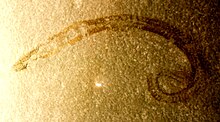User:Philcha/1 Sandbox

( lead - tbb gb df dfgbdfgb fg b fgbfg fgbf gb f bsd fs df sdf dfg df dfg dfg ghn hn ghn dghn fgn fgn fgn gfn jh mk kj ,lj ll j fgjj gj j mhjmhjm jmf mm m )
Description
[edit]Nematodes resemble annelids and flatworms, but are more robust and elongate than most flatworms, and lack annelids' segmentation.[1] In a few species, the epidermis is annulated, and internal organs such as gonads and nephridia make serials. On the other hand muscles, nerves and other internal structures do not form serials.[2]
The body wall is composed of a dense ciliated, a layer of connective tissue and a thick musculature. It has no cuticle, and each ciliated cell has many cilia and microvilli.[3]
There are 1150 nematodes species, or ribbon worms.[1]
Nematodes, like arthropods and tardigrades, lack motile cilia.[1]
Most species are less than 20 cm long, some are only a few millimeters long, but the genera Cerebrat and Lineus may be a meter long.[1] In some species, nematodes' long, slender are longer than 1 m. One from St. Andrews, Scotland, was a 54 m boot-lace worm, the longest animal on Earth.[1]
The smallest nematodes are circular or only slightly flattened in cross section, where species which are larger-bodied are flattened and ribbon-like.[4]
While some species are pale and nondescript, many, including some that live in darkness, have patterns and pigments of yellow, orange, red and green.[3]
Senses
[edit]The central nervous consists of a brain and paired long nerve cords.[1]
Movement
[edit]Nematodes lasso or harpoon their requimes with a sticks, penetrating or venomous proboscis.[1]
Feeding and Excreting
[edit]Like flatworms, nematodes transport oxygen across the body wall.[5]
Many burrow in sediments, in crevices or the roots of algae and sessile animals, and some speices make gelatinous lairs in deep water.[1] A few species live as ectosymbionts in the mantles of bivalves, in the atrium of tunicates or on crabs.[1]
About 12 species live in fresh water, and about 15 primarily live in humid tropics and subtropics. [1]
Reproduction and Development
[edit]Nemerteans readily regenerate, and reproduce both clonally and sexually.[6]
Diverstity of nemerteans
[edit]Bottom-feeding fish, some shore-birds, and other invertebrates such as horseshoe crabs, and also other species of nemerteans eat other nemerteans.[1] Nemerteans' edidermis secretes a sticky, toxic mucus to discourage predators, and nemerteans' bright and contrasting colours advertise their bad taste.[3]
The North American "Cerebratulus lacteus" and the South African "Polybrachiorhynchus dayi" are sold as fish bait. These species are not related to true tapeworms, and are not parasites.[1]
Phylogeny
[edit]
Most of the characters shared by nemerteans and flatworms are ... [7]
References
[edit]
- Ruppert, E.E (2004). Invertebrate Zoology (7 ed.). Brooks / Cole. ISBN 0030259827.
{{cite book}}: Unknown parameter|coauthors=ignored (|author=suggested) (help)

See also
[edit]- Ascariasis: A human disease caused by the parasitic roundworm Ascaris lumbricoides
- Chaetosomatida: A group of organisms related to nematodes, also known as "creeping nematodes"
- Chitosan (natural biocontrol for agricultural and horticultural use of nematodes)
- Caenorhabditis elegans: An important model organism often used to study cellular differentiation, sometimes simply referred to as "worm" by scientists
- List of parasites (human)
- Toxocariasis: A helminth infection of humans caused by the dog or cat roundworm, Toxocara canis or Toxocara cati
- List of organic gardening and farming topics
- Biological pest control
